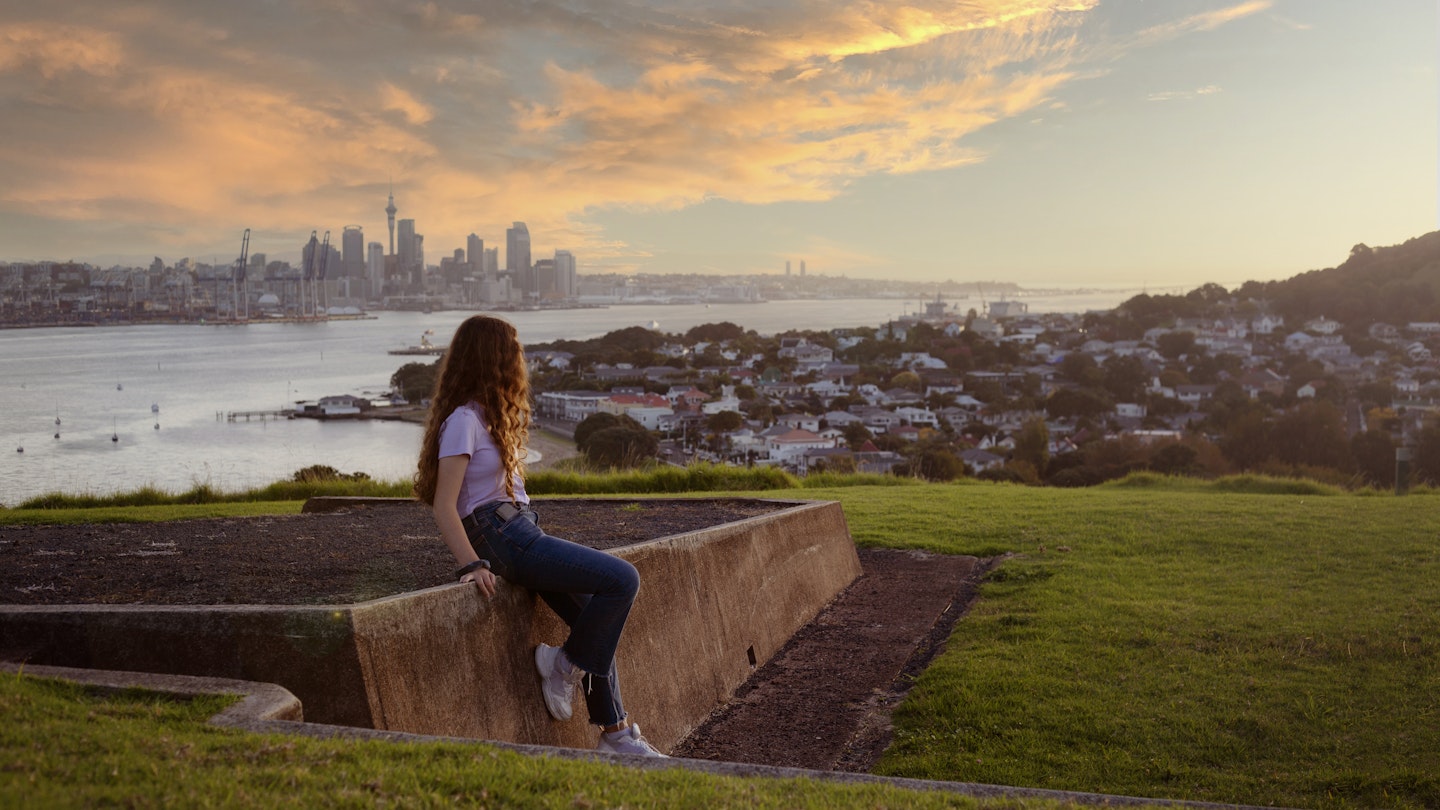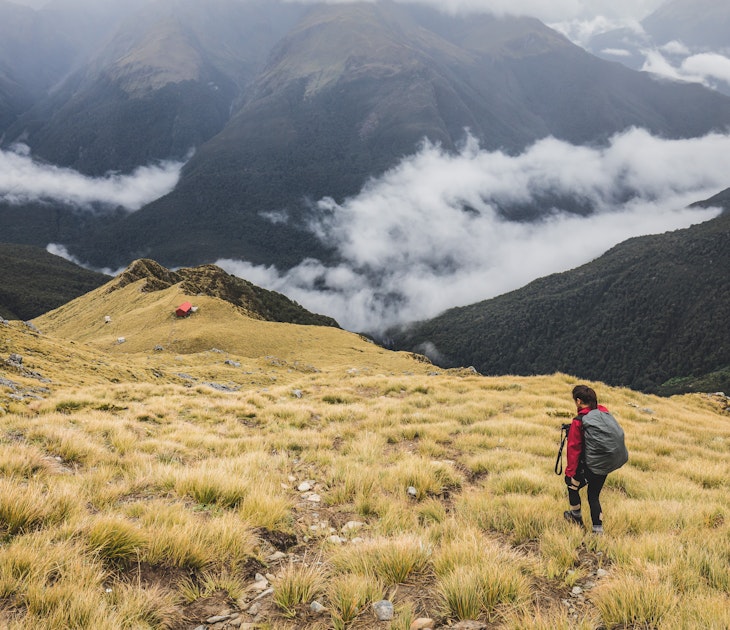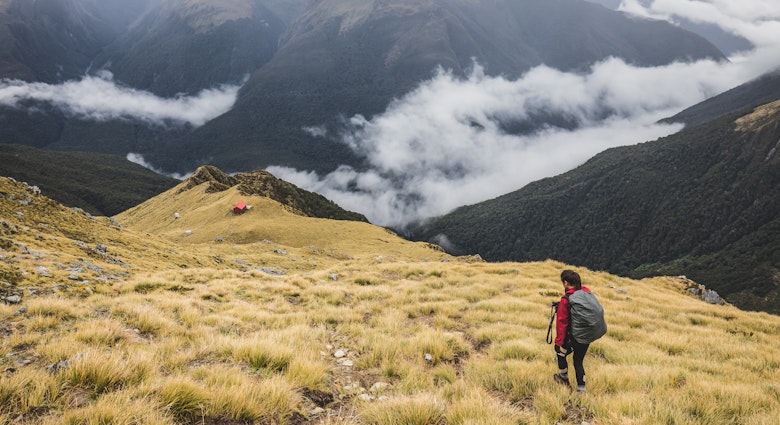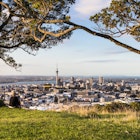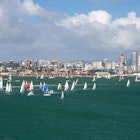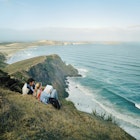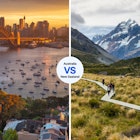Straddling a narrow isthmus between two harbors, Auckland is New Zealand’s biggest and most cosmopolitan city, and getting around by public transport involves a jigsaw of different services on land and sea.
For locals, travel by car is the most popular option; this keeps the roads busy, so stay off the freeway system during the morning and afternoon rush hours. For visitors to the city, a combination of city buses, local ferries and the occasional short hop by rideshare, electric scooter or e-bike will deliver you to all of Auckland’s highlights.
Here's what you need to know about getting around in Auckland.
Grab an AT HOP pass to save on Auckland public transport
Auckland’s buses, trains and ferries are run by a collection of different operators, but the integrated AT HOP stored-value card provides discounts of at least 20% on most buses, trains and ferries. It costs NZ$5 (US$2.95) to buy an AT HOP card, and you can then recharge the card as needed, with a NZ$1 (US$0.59) minimum.
The initial card cost is non-refundable, so it's really only worthwhile if you're planning an extended stay in Auckland. You'll need to tap in and tap out for each journey, but the total you'll pay for transport in a single day is capped at NZ$20 (US$11.79). The Auckland Transport website has a list of venues where you can buy and charge AT HOP cards.
Travel around the inner city by bus
Auckland Transport's extensive bus system reaches most parts of this sprawling city, albeit with varying degrees of frequency and punctuality. The most important buses for travelers are the Link routes, which connect many sights in and around the center.
Bright green InnerLink bus routes loop around the inner city, stopping at many key destinations, including the Auckland Museum, the waterfront bars and restaurants of Viaduct Harbour, and the eating, drinking and shopping precincts of Ponsonby, Karangahape Road and Newmarket.
Orange-colored OuterLink buses will take you to the Auckland Zoo and MOTAT, Auckland's excellent transport and technology museum, while red CityLink buses are the best option if you plan on eating and drinking by the harborside in the Wynyard Quarter. CityLink buses are fully electric, with plans to electrify the entire fleet underway.
Bus fares start at NZ$1 (US$0.59) one-way on CityLink buses, or NZ$4 (US$2.36) on other routes. You'll pay around half this with an AT HOP card (and get free travel on the CityLink bus if you change from another AT HOP journey). Cash fares are not accepted on buses.
Tip for bus travel in Auckland: For an impromptu city tour, ride the InnerLink bus to brunch in Ponsonby, followed by an afternoon at the Auckland Museum, then have dinner and cocktails among the super-yachts at the Viaduct Harbor.

Jump on a local train to the game
The Auckland Transport network also includes three train lines, mainly serving the city's eastern, western and southern suburbs. The Western Line from Britomart is handy for sport and music fans attending live sport and concerts at nearby Eden Park, while the Southern Line stops at Mt Smart Stadium, Auckland's other major sports venue.
Due to be completed in late 2024, Auckland's underground City Rail Link will make for easier commuter travel in the CBD (as the downtown core is known). Check their website for progress reports on the project.
Tip for sports fans in Auckland: Fans of rugby are spoiled for choice in Auckland. Take the train to Eden Park to watch Super Rugby with the Auckland Blues, or to Mt Smart Stadium to watch Moana Pasifika, a rugby union team drawn from multiple Pacific Island nations.
Take the ferry for an island day full of beaches and wine
Framed by two natural harbors and surrounded by the islands of the Hauraki Gulf, Auckland is a city that was made for exploring by water. From downtown Auckland's Edwardian-era Ferry Building, Fullers360 runs regular passenger services across Waitematā Harbour to the historic seaside suburb of Devonport, and further afield to Waiheke Island, the city's favorite escape.
Less frequent ferries depart to the protected island bird sanctuary of Tiritiri Matangi, and Rangitoto, a dormant 700-year-old volcanic island on the eastern edge of the Hauraki Gulf. Rangitoto is crisscrossed by walking trails and linked to neighboring Motutapu Island by a causeway.
Top tip for a day out by ferry: Taking the Fullers ferry to Waiheke Island offers a rewarding day out for oenophiles. From the Matiatia Ferry Terminal, the number 50 bus travels to a string of vineyard restaurants in the village of Onetangi, including Tantalus Estate and Te Motu. Onetangi also has a long and lovely beach.
Why ferries are my favorite way to travel in Auckland
I always love leaving downtown on a ferry, looking out at the graceful arc of the Auckland Harbour Bridge, and heading out for a day’s adventure. Whether it’s just a short hop to Devonport, or a longer trip to Waiheke Island, I always feel more relaxed just a few minutes into the journey.
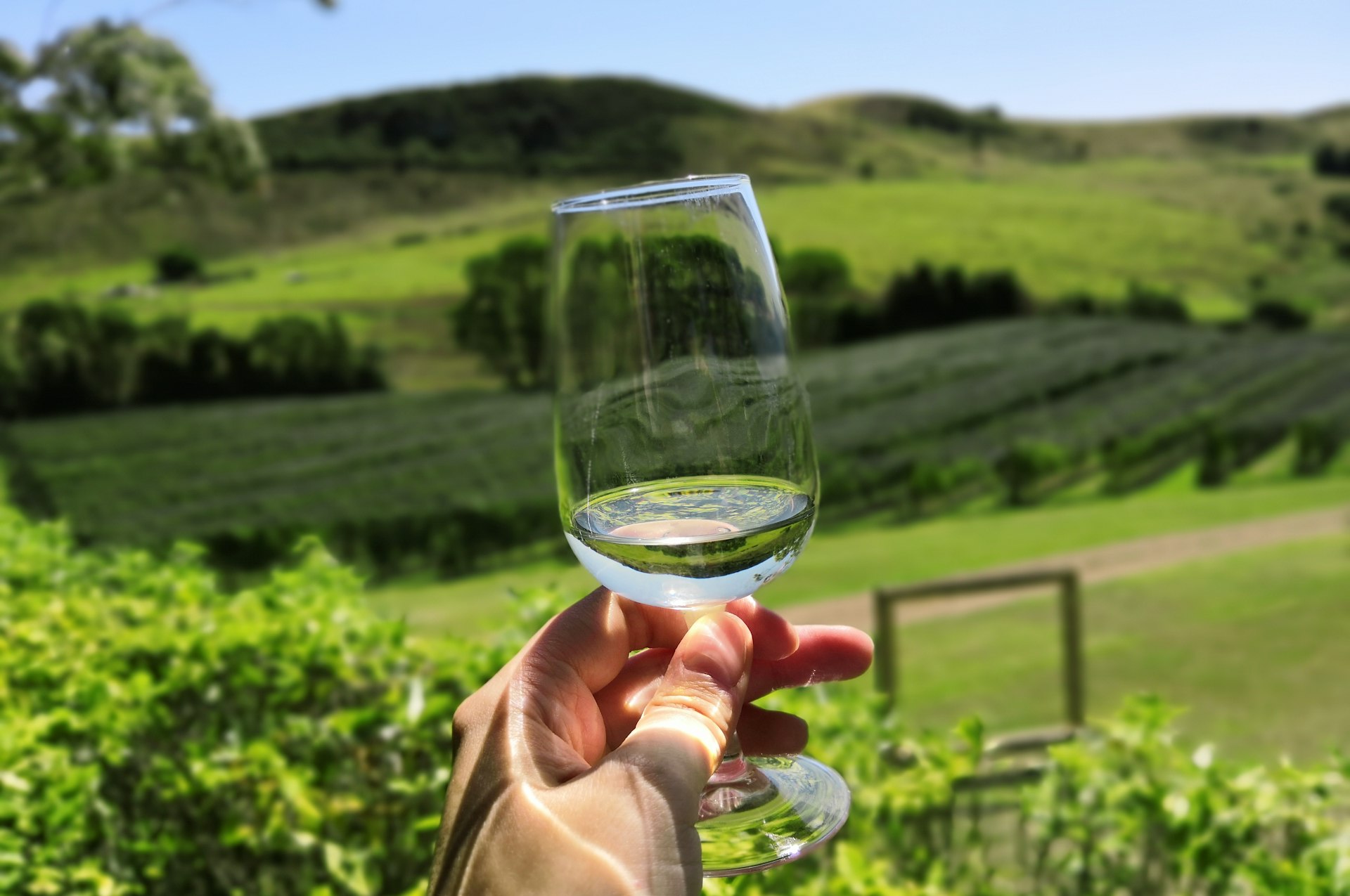
Use rideshares for easy transfers when bar-hopping
Auckland is well-served by taxi companies, and cheaper rideshare services – handy when hopping between the seven taprooms and bars along the Auckland Beer Mile (actually around 4.5km). International operators Uber and Ola are joined by local player YourRide; all three apps can be downloaded on the Apple App Store and Google Play.
Rideshare services are generally around 20-30% less expensive than taxis for the same distance. However, following a big sports event or concert, surge pricing inevitably kicks in and regular taxis can actually sometimes be less expensive than rideshares.
Zip by electric scooter to reach Auckland's best city beaches
Electric scooters and e-bikes can also be accessed via the Uber app, with interactive maps showing the location of scooters and bikes around town. It's an excellent option for short hops around the city or for exploring the harborside Wynyard Quarter precinct. Rival company Beam also offers electric scooters, while nextbike provides modern pedal-powered transport; book vehicles via their apps.
Note that Uber's scooters and e-bikes and Beam's scooters can be left anywhere in the city at the end of a one-way journey, but nextbikes must be parked at one of their official rental stations, all of which are in the CBD and central Auckland suburbs. There's a NZ$2 (US$1.18) surcharge if a bike is left in nextbike's Flexzone – indicated on its website – and not at a rental station.
Top tip for a day out by electric scooter: Electric scooters and e-bikes are a great way to explore the various bays and beaches of Tāmaki Drive. A 10km (6.2 mile) ride from downtown will take you to good swimming beaches and waterfront restaurants at St Heliers. Rather than cycling back to town, you can take the InnerLink TāmakiLink bus back to the CBD.
In Auckland, (mostly) give the car a miss
Driving a car is not recommended if your Auckland sojourn is mainly focused on the central city and the waterfront. Parking is expensive and increasingly hard to find in key areas including the CBD and Karangahape Road, where the council has installed bike paths and replaced parking spots with pedestrian-friendly street furniture and shared spaces.
It is, however, worth considering renting a car for easy day trips out of Auckland, particularly if your accommodation has parking. The usual international hire firms have offices at the airport and in the center. For a rewarding day drive, follow Scenic Drive through a twisting forest-clad labyrinth to reach the surf beaches of Auckland’s rugged west coast.
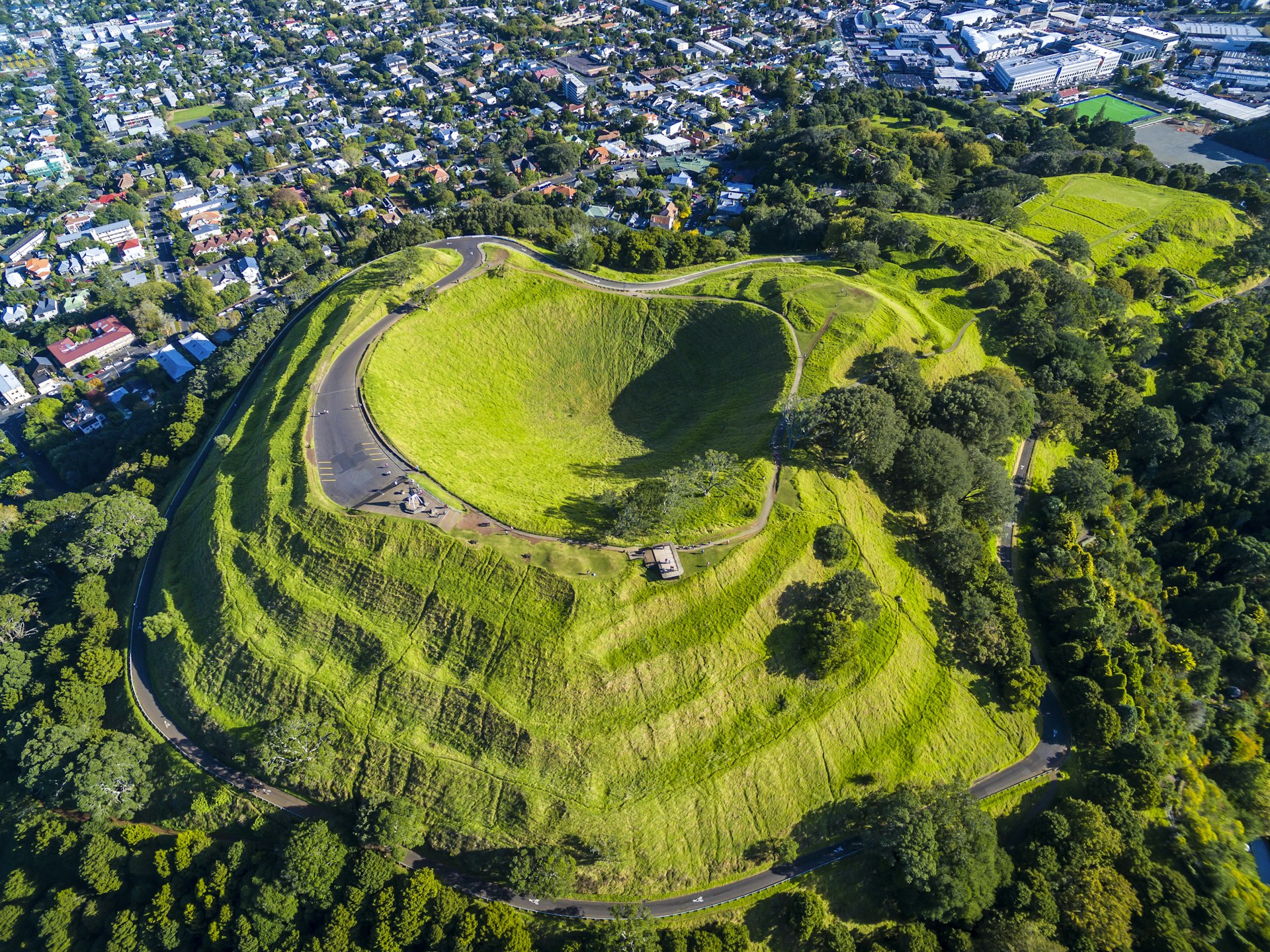
Check out Auckland’s urban volcanoes on foot
Auckland is not a great city for walking as it sprawls across a wide area, and its inner suburbs are built on ridges and are relatively hilly. However, a good way to get a handle on the city’s terrain and layout is to walk up a few of its maunga (ancestral mountains). These dormant volcanoes are culturally and historically important as the sites of former Māori pā (fortified settlements) in earlier centuries.
If you only have time for one walk, climb up Mt Eden (Maungawhau) to the visitor center and negotiate the boardwalks at the summit to reach a fine viewing platform overlooking the CBD and the SkyTower. Bus 27 runs from the Britomart Transport Centre to Tahaki Reserve at the base of the volcano.
Accessible Transportation in Auckland
Ninety percent of Auckland buses have the ability to "kneel" to allow passengers with mobility issues and wheelchair users to board, or have ramps to facilitate easy access. It’s worth checking the AT website to see if a specific bus route has these features. For visually-impaired travelers, a growing number of bus stops feature on-request audio announcements, schedule information in braille, and larger icons and fonts.
Wheelchairs can also be carried on all trains and most ferries; double-check online with the ferry owners before you travel. For more information, see Lonely Planet's Accessible Travel Resources.
